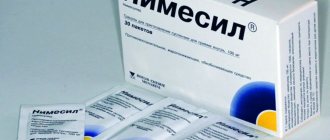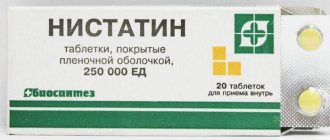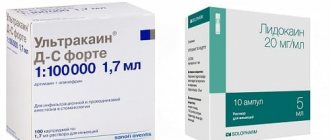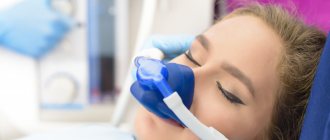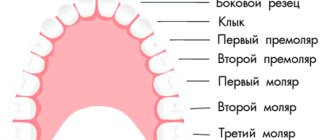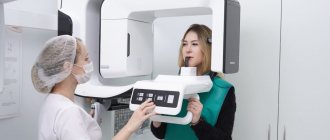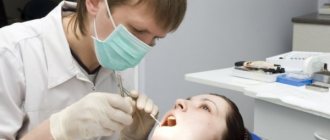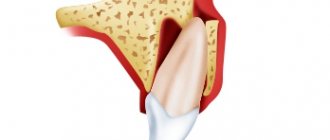30.08.2017
The occurrence of toothache is a consequence of significant damage to the structure of the tooth. The cause of pain is the penetration of infection through the hard part to the pulp. Timely treatment and examination of the condition of your teeth will help to avoid such a problem.
However, toothache does not come according to schedule and almost always unexpectedly, in most cases during doctors’ non-working hours. You can try to overcome the pain on your own until you can make an appointment with a dentist.
How to eliminate pain using conventional means - basic recipes.
You can use the following set of recipes:
- Use a sage decoction, rinsing your mouth with the mixture still warm, holding the liquid near the tooth for as long as possible. Rinse 4 times for 20 minutes.
- You can use onion peels for rinsing. It is brewed in boiling water, allowed to stand for a while and filtered. Then rinse the mouth with the resulting decoction 3 times for 10 minutes.
- Melissa is also an excellent ingredient for making a decoction. Crushed lemon balm is poured with boiling water, maintaining a ratio of 1 tbsp. spoon for 1 glass of water. Let it brew, strain and rinse your mouth.
- Amazing properties are stored in ordinary red beets (in raw form). Place the slice on the source of pain and hold until relief occurs.
- Fresh Kalanchoe leaf is also effective. It is enough to knead it and place it on the tooth. The juice acts directly, relieving pain and disinfecting the application area.
- If you have a hollow, you can take an ordinary cotton wool soaked in clove oil and apply it to the source of pain.
- If the tooth has an open nerve, then you need a cotton swab, which should first be moistened with a carbolic acid solution. The pain from it subsides quickly, but such a cotton wool must be closed, otherwise the solution may begin to destroy healthy teeth. You can cover the embedded cotton wool either with wax or with another cotton wool that has been soaked in collodium. The placed cotton wool is removed after 2 days; if the pain no longer occurs, a new cotton wool is placed and they go to the hospital to have a filling installed.
Tincture of calamus and propolis.
Tinctures must be prepared in advance and not mixed before use. The first tincture - in a ratio of 1 to 5, pour vodka over the root of calamus and leave to infuse for 10 days. The second tincture is also based on vodka. You need 15 grams of propolis (which needs to be crushed) per 100 grams of vodka. It also infuses for 10 days. Both tinctures must be stored in a cool, dark place.
Tinctures are used as follows: take one tablespoon of calamus (tincture) and half a tablespoon of propolis (tincture), stir and rinse your mouth with the resulting mixture for 10 minutes. After rinsing, the mixture must be spat out.
Getting rid of pain due to pulpitis.
To avoid sudden toothache, high-quality prevention is necessary. These include appropriate regular hygiene procedures and certain food restrictions. It is necessary to limit yourself in consuming sweets (at the same time, this will have a positive effect on your figure). You should not take temperature-contrasting food - for example, after hot borscht, eat ice cream. Such recommendations should be especially taken into account when the nearest dental clinic is far away, and there are no pharmacies nearby.
The most common cause of toothache is pulpitis. It develops from caries when the infection penetrates deep into the tooth and reaches the pulp. The pain from pulpitis intensifies at night and can “radiate” to the temporal region, towards the ear or throat. To calm an attack of such pain, you need to rinse your mouth with a warm solution of furatsilin (0.2%). An enhanced effect can be achieved by adding a teaspoon of table soda.
When this method does not help, you need to take painkillers (analgesics) and see a dentist as soon as possible.
There are other, conventionally called reflex, methods for eliminating pain due to pulpitis. For example, placing a heating pad on the back of the neck, or a bag of grated horseradish or mustard (to warm it up).
You can also use your fingers - placing their pads on the sore spot.
Propolis.
This amazing compound produced by bees contains over 100 different substances. In addition, it is a wonderful antiseptic that does not allow any types of microbes to pass through and blocks the work of their enzymes (so microorganisms will not be able to gain a foothold on the target object).
Propolis is also quite effective in helping with toothache. However, it works great as a dental protection for preventive purposes. Its effect is possible both in its natural form and as part of an alcohol tincture. In addition, it can replace novocaine (they say that it is even better) if you soak a cotton swab in its tincture and apply it to the aching tooth.
Although this does not cancel a visit to the dentist, you will definitely need to visit him.
Use of novocaine for electrophoresis, compresses and antibiotic dilution
Electrophoresis with novocaine is not very effective. It is best to use the anesthetic Lidocaine 2% for electrophoresis (sold in ampoules of 2 ml).
Compress with dimexide and novocaine -
Compresses with dimexide are very often prescribed by maxillofacial surgeons, especially for traumatic injuries to the face (for example, fractures of the facial bones). A prerequisite is that there should be no violation of the integrity of the skin in the area where the compress is applied. Compresses with dimexide can reduce swelling and inflammation of soft tissues much faster; for example, in case of a broken jaw, just a few procedures are enough.
Dimexide concentrate (in 100 ml bottles) –
Dimexide with novocaine compress: the proportions of the compress with dimexide and novocaine are used only externally. When applying a compress on the face, you need to use a 20-25% concentration of dimexide. To do this, dilute dimexide in the following proportion: 1 part dimexide - three parts warm boiled water. When used on less sensitive areas of the body, you can use more concentrated solutions (30, 35, 40%).
Moisten gauze pads with a solution diluted with water. Apply the contents of 1 ampoule of novocaine (5 ml of solution) directly onto moistened wipes. Apply the wipes to the desired area. Place a plastic film over the napkin, completely covering the area of the applied gauze napkin with the solution. Place a layer of fabric on top of the polyethylene (the thicker the fabric, the stronger the thermal effect will be - keep this in mind!) and bandage it.
The time of one compress is 20-30 minutes. The course of treatment is 10-12 procedures (1 procedure per day). From experience, we can say that to enhance the analgesic effect, it is better to use lidocaine rather than novocaine (2-4 ml of lidocaine per 1 compress). Lidocaine penetrates the skin better, is less allergic, and its analgesic effect is 2 times stronger.
Dimexide: how to apply a compress (example)
→ DIMEXIDE instructions for use (official, PDF)
How to dilute ceftriaxone with novocaine -
It is not advisable to dilute the antibiotic Ceftriaxone with novocaine, because the antibiotic itself is quite allergenic, and novocaine increases the risk of developing anaphylactic shock many times (compared to lidocaine). It is optimal to dilute ceftriaxone with a lidocaine solution (this is also recommended by WHO). This anesthetic is much less allergic and has a stronger analgesic effect.
500 mg of ceftriaxone must be diluted in 2-2.5 ml of solvent. To dilute 1000 mg of ceftriaxone - 3.5-4 ml of solvent. The latter can be used either water for injection or a 0.5-1% solution of novocaine, but best of all is a 1% solution of lidocaine. But in order to dissolve ceftriaxone in lidocaine, you will still have to use water for injection, because. the concentration of lidocaine in ampoules is 2%.
For example, to obtain a 1% lidocaine solution for diluting 500 mg of ceftriaxone, you will need to first draw 1.0 ml of lidocaine into a syringe, and then another 1.0 ml of water for injection into the same syringe. Then add the resulting solution to the vial with ceftriaxone and shake.
Cefazolin: how to dilute with novocaine
Let us say right away that it is undesirable to dilute cefazolin with novocaine, as well as ceftriaxone (for the same reasons). It is also best to use a 1% lidocaine solution. To dissolve 1000 mg of cefazolin, 4 ml of a 1% lidocaine solution is needed. To obtain a 1% solution of lidocaine, you need to mix 2 ml of lidocaine and 2 ml of water for injection in a syringe, drawing both solutions in turn into one syringe. The resulting solution is injected into a cefazolin ampoule. We hope that our article on the topic “Novocain - instructions for use” was useful to you!
Sources:
1. Dental education of the author of the article, 2. Personal experience as a dental surgeon, maxillofacial surgeon, 3. National Library of Medicine (USA), 4. “Local anesthesia in dentistry” (Baart J.), 5. “Propaedeutics of surgical dentistry" (Soloviev M.).
Other rinse-based methods.
Considering the question - how to relieve toothache
, it should be noted that there are many fairly simple methods. For example, when a toothache appears, you can eliminate it by rinsing your mouth. This happens, for example, if food gets into the damaged area of the tooth. Remains of food put pressure on the “sore spot” and cause pain. In this case, simply rinsing the mouth with a soda solution will help. The pain may go away completely.
If this method fails to get rid of the pain, then you need to brew special herbs that have anti-inflammatory and analgesic effects. Let's look at some of them:
- Sage tea. One tablespoon of sage is poured into one glass of boiling water and gradually cools down to just warm. After which it is filtered. Rinse the mouth with this infusion while still warm. In addition to sage, herbs such as calendula, St. John's wort, chamomile or oak bark are suitable.
- Using the prepared herbal mixture, you can stop acute toothache. To prepare it, you need to take 3 parts of celandine, 4 sage and 4 oak bark. This set is poured with boiling water and left for one hour. Then the mixture must be boiled for 3 minutes. This is followed by cooling and straining. It is necessary to rinse the mouth with infusion 5 times a day.
- Infusion of calendula, which is used to rinse the mouth on the sore side. To prepare it you will need one tablespoon of calendula and a glass of boiling water. It is necessary to brew with the lid on until the infusion reaches a warm temperature.
- Onions and garlic are also powerful medicines. It is enough to saturate the cotton wool with juice and place it in the “hollow” of the diseased tooth. You can also put a piece of garlic clove in there.
Novocain: reviews of anesthesia
Novocain's instructions for use, as well as my personal experience of using this anesthetic in dentistry and maxillofacial surgery, indicate the following clinical characteristics of the drug. For infiltration anesthesia on the upper jaw, the duration of “effective” anesthesia with novocaine is only about 10 minutes. With conduction anesthesia on the lower jaw, the duration of “effective” anesthesia is most often about 30 minutes.
The above figures will be correct if we work with a 2% novocaine solution without adding a vasoconstrictor solution, for example, epinephrine hydrochloride. To reduce the leaching of novocaine from the injection site (through the bloodstream), an additional 0.1% solution of epinephrine hydrochloride is added to the novocaine solution. This will slightly increase the duration of pain relief and the depth of anesthesia. Typically, 1 drop of a vasoconstrictor is added for every 2, 5 or 10 ml of novocaine - depending on the expected duration of the intervention and the somatic status of the patient.
The only advantage of anesthesia with novocaine over other anesthetics is its low toxicity. Anesthetics such as lidocaine and mepivacaine are 2 times more toxic than novocaine, and articaine is 1.5 times more toxic.
Disadvantages of novocaine –
- weak analgesic effect,
- short duration of anesthesia,
- slow onset of anesthesia,
- novocaine is a strong allergen (it ranks 4th among all drugs - the most often causing anaphylactic shock),
- has the property of lowering blood pressure (this is also why it is also advisable to use it only together with vasoconstrictors),
- Novocaine should absolutely not be used during pregnancy or breastfeeding,
- lack of analgesic effect in inflamed tissues (at the site of inflammation there is always an acidic pH, at which the effectiveness of novocaine sharply decreases, and this does not allow achieving good pain relief for purulent inflammation).
Novocain: price and release forms
Novocaine ampoules can contain either a 0.5% solution or a 2% solution. The cost of 1 package of novocaine (10 ampoules of 5 ml each) will be about 50 rubles. The modern form of release of Novocain is in special plastic ampoules, which replaced glass ones. Such ampoules are much safer when opened, and in addition, it is much more convenient to draw anesthetic from them into a syringe (this can be done without a needle).
Needle-free set of novocaine into a syringe (diagram):
Adverse reactions to anesthesia with Novocaine:
Novocaine can cause headache, dizziness, drowsiness, as well as weakness and trismus. From the cardiovascular system, possible decreases (more often) or increases (less often) in blood pressure, peripheral vasodilation, bradycardia, as well as collapse, arrhythmias and chest pain. On the part of the hematopoietic organs, methemoglobinemia is possible.
Allergic reactions: skin rash and itching, as well as urticaria (on the skin and mucous membranes), may occur. Anaphylactic reactions, including anaphylactic shock, may occur. The high frequency of side effects of novocaine is associated, among other things, with its low connection with blood plasma proteins when the anesthetic solution enters the bloodstream. For example, the binding of novocaine to blood plasma proteins is only about 5-7% - compared to lidocaine, this figure is 65%, and articaine is 95%.
Important: please note that novocaine is contraindicated for use in children under 12 years of age, as well as in pregnant women. The use of novocaine in women during lactation always requires temporary cessation of breastfeeding. The use of the drug at the age of 12 to 18 years, as well as in elderly patients over 65 years of age, is possible, but with great caution.
Essential oils.
Since ancient times, the properties of essential oils have been used; their use is called aromatherapy. Indeed, they obtained from a variety of plants have a bactericidal and anti-inflammatory effect. A large number of them can have an analgesic effect. Therefore, the use of essential oils to relieve toothache has become widespread. Oils can be used to massage the gums, or soak cotton wool in them and place them on the tooth, or even make a compress on the cheek. Let's look at how to relieve toothache using folk remedies.
using aromatic oils:
- Once upon a time, unopened and dried carnation flowers were difficult to obtain. This is not only a well-known spice - this plant has many amazing properties. For example, the oil obtained from the petals of this plant has a strong effect. A cotton wool soaked in it and placed in the “hollow” of a diseased tooth is quite effective. However, it should be noted that there may be an allergic reaction to it.
- One of the most powerful natural analgesics is cajuput oil. It works effectively when applying compresses. This oil has an antiseptic effect and relieves swelling. The method of application is simple - apply 4-5 drops of essential oil to a damp bandage and apply it as a compress on the sore side to the cheek.
- Peppermint oil works in a similar way, only you need to moisten a cotton swab with it, which is applied to the tooth, and then replace it until the pain subsides.
- Various mixtures of oils can also be used. So 1 drop of clove oil with 2 drops of mint and 2 lavender, dissolved in a teaspoon of almond oil is also very effective. To apply, use cotton wool, which is moistened with the mixture and applied to the tooth.
Modern analogues of novocaine in dentistry -
Lidocaine replaced novocaine around the 90s. Lidocaine is 2.5 times stronger than novocaine in terms of depth of anesthesia and duration of effect, and it does not lose effectiveness when administered in the area of inflammation (for example, with purulent abscesses). Lidocaine also has a much lower incidence of side effects. But as we said above, in dentistry lidocaine is now used only in provincial medical institutions, because In terms of depth and duration of anesthesia, lidocaine is 2-3 times inferior to articaine preparations (for example, ultracaine).
Lidocaine 2% solution in ampoules of 2 ml –
And although lidocaine is now practically not used in dentistry, in general surgery it is still one of the most widely used local anesthetics (24stoma.ru). The most popular anesthetics in dentistry today are drugs based on articaine (for example, ultracaine, ubistezin, septanest and others). For dentists, these drugs are no longer produced in glass or plastic ampoules, but in special glass carpules.
Carpule syringe and anesthetic carpules –
Each capsule contains 1.7 ml of anesthetic and is ready for use (i.e. it does not need to be opened). It is completely inserted into a special carpule syringe, into which a special double-sided needle is then screwed in from the side of the syringe nose. When you press the syringe plunger, the latter presses on the movable rubber tab located in the lower part of the carpule, which causes an increase in pressure inside the carpule and leads to the release of the anesthetic solution through the needle into the tissue.
How is anesthesia performed in dentistry?
For more information about modern anesthesia in dentistry, read the article: → Pain relief in dentistry
Tested methods:
- For toothache. Consists of two ingredients. The first tincture - in a ratio of 1 to 5, pour vodka over the root of calamus and leave to infuse for 10 days. The second tincture is 15 grams of propolis (which needs to be crushed) per 100 grams of vodka. It also infuses for 10 days. Both tinctures must be stored in a cool, dark place. Usage – take one tablespoon of calamus (tincture) and half a tablespoon of propolis (tincture), mix and rinse your mouth with the resulting mixture for 10 minutes. After rinsing, the mixture must be spat out.
- One of the most terrible types of toothache is crown pain. It is impossible to solve the problem by direct influence - there is no access, and time drags on slowly. The recipe for the solution is simple - you need to mix a teaspoon of soda and extremely finely ground table salt, and brush your teeth with this powder 3 times a day. However, it is necessary to rinse your mouth after brushing only after 10 minutes.
Back
Novocaine
Dosage form
Rectal suppositories
Compound:
one suppository contains:
Active substance
: Procaine hydrochloride (Novocaine) – 0.1 g.
Excipients
: Solid fat (Vitepsol (brands N 15, W 35), Supposir (brands NA 15, NAS 50)) – until a suppository weighing 1.2 g is obtained.
Description
Suppositories are white or white with a yellowish tint, torpedo-shaped.
Pharmacotherapeutic group
Local anesthetic.
ATX code
: C05AD05.
pharmachologic effect
Pharmacodynamics
A local anesthetic with moderate anesthetic activity and a wide range of therapeutic effects. Being a weak base, it blocks sodium channels, preventing the generation of impulses at the endings of sensory nerves and the conduction of impulses along nerve fibers. Changes the action potential in the membranes of nerve cells without a pronounced effect on the resting potential. Suppresses the conduction of not only pain, but also impulses of other modalities.
Pharmacokinetics
Subject to complete systemic absorption. It is quickly hydrolyzed by plasma and liver esterases to form 2 main pharmacologically active metabolites: diethylaminoethanol (has a moderate vasodilator effect) and para-aminobenzoic acid (is a competitive antagonist of sulfonamide chemotherapeutic drugs and can weaken their antimicrobial effect).
Indications for use
As a local anesthetic for hemorrhoids and anal fissures.
Contraindications
Hypersensitivity (including to para-aminobenzoic acid and other local anesthetic esters), children's age (up to 18 years).
Carefully
Emergency operations accompanied by acute blood loss, conditions accompanied by decreased hepatic blood flow (for example, with chronic heart failure, liver disease), progression of cardiovascular failure (usually due to the development of heart block and shock), proctitis, pseudocholinesterase deficiency, renal failure, in elderly patients ( over 65 years old), seriously ill, debilitated patients, pregnancy, childbirth.
Use during pregnancy and breastfeeding
During pregnancy and lactation, the drug should be used when the benefit to the mother outweighs the risk to the fetus or child.
Directions for use and doses
Rectally. The suppository is inserted deep into the anus (after a cleansing enema or spontaneous bowel movement), having previously freed the suppository from the contour packaging using scissors (cutting the packaging along the contour of the suppository). Use 1 suppository 1-2 times a day. The duration of treatment as a local anesthetic is no more than 5 days. If pain persists, you should consult a doctor.
Features of the action of the drug when first taken or when discontinued
No information available.
Side effect
From the nervous system
: headache, dizziness, drowsiness, weakness, motor restlessness, loss of consciousness, convulsions, trismus, tremor, visual and auditory disturbances, nystagmus, cauda equina syndrome (leg paralysis, paresthesia), paralysis of the respiratory center.
From the side of the heart
: bradycardia, arrhythmias, chest pain.
From the side of blood vessels
: increase or decrease in blood pressure, peripheral vasodilation, collapse.
From the kidneys and urinary tract
: involuntary urination.
From the gastrointestinal tract
: nausea, vomiting, involuntary defecation. Blood disorders: methemoglobinemia.
Allergic reactions
: itching of the skin, skin rash, other anaphylactic reactions (including anaphylactic shock), urticaria (on the skin and mucous membranes), dizziness, weakness, decreased blood pressure. In these cases, you should stop using the drug and consult a doctor.
Local reactions
: in the first days of using the drug, there may be a urge to defecate and a feeling of discomfort, which later go away on their own and do not require discontinuation of the drug. Rarely – hyperemia and itching in the anal area (when used in high doses).
Overdose
Symptoms
: pallor of the skin and mucous membranes, dizziness, nausea, vomiting, “cold sweat”, increased breathing, tachycardia, decreased blood pressure, up to collapse, apnea, methemoglobinemia. The effect on the central nervous system is manifested by a feeling of fear, hallucinations, convulsions, and motor agitation.
Treatment
: maintaining adequate ventilation of the lungs with oxygen inhalation, intravenous administration of short-acting drugs for general anesthesia, in severe cases - detoxification and symptomatic therapy.
Interactions with drugs
Local anesthetics enhance the inhibitory effect of other drugs on the central nervous system. Anticoagulants (ardeparin sodium, dalteparin sodium, danaparoid sodium, enoxaparin sodium, heparin, warfarin) increase the risk of bleeding.
When used with monoamine oxidase inhibitors (furazolidone, procarbazine, selegiline), it increases the risk of lowering blood pressure. Vasoconstrictors (epinephrine, methoxamine, phenylephrine) prolong the local anesthetic effect. Procaine reduces the antimyasthenic effect of anticholinesterase drugs, especially when used in high doses, which requires additional correction of the treatment of myasthenia gravis.
Cholinesterase inhibitors (antimyasthenic drugs, cyclophosphamide, demecaria bromide, ecothiopathy iodide, thiotepa) reduce the metabolism of local anesthetic drugs. The metabolite of procaine (para-aminobenzoic acid) is an antagonist of sulfonamides, which leads to a weakening of the antimicrobial effect.
special instructions
Patients require monitoring of the functions of the cardiovascular system, respiratory system and central nervous system. It is necessary to discontinue MAO inhibitors at least 10 days before using the drug.
Impact on the ability to drive vehicles and machinery
During the treatment period, care must be taken when driving vehicles and engaging in other potentially hazardous activities that require increased concentration and speed of psychomotor reactions.
Release form
Rectal suppositories 100 mg.
5 suppositories in a blister pack.
Two contour blister packs, together with instructions for medical use of the drug, are placed in a box of cardboard.
Storage conditions
In a place protected from light at a temperature not exceeding 25 ° C.
Keep out of the reach of children.
Best before date
2 years. Do not use after the expiration date stated on the label.
Vacation conditions
Available without a prescription.
